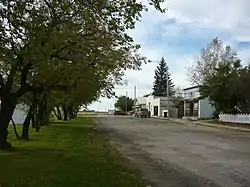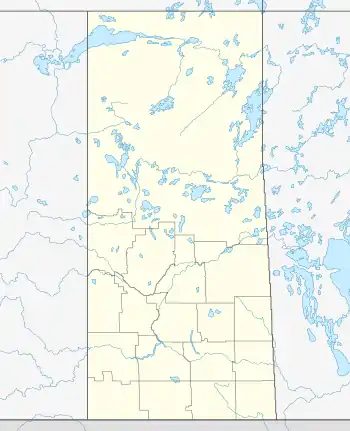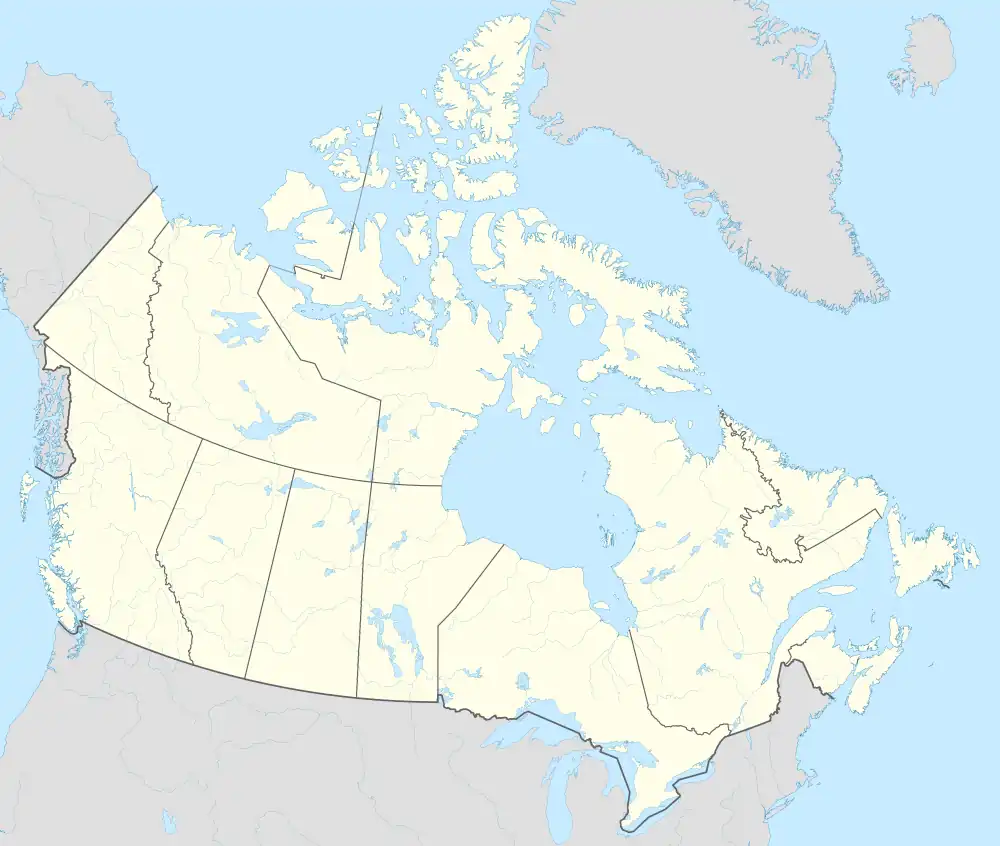Prud'homme | |
|---|---|
Village | |
 Railway Avenue | |
 Prud'homme  Prud'homme | |
| Coordinates: 52°20′13″N 105°53′35″W / 52.337°N 105.893°W | |
| Country | Canada |
| Province | Saskatchewan |
| Region | Saskatchewan |
| Census division | 15 |
| Rural Municipality | Bayne |
| Post office Founded | February 1, 1906 |
| Incorporated (Village) | 1908 |
| Named for | Joseph H. Prud'homme |
| Government | |
| • Mayor | Stacey Wutzke |
| • Administrator | Barbie Stachniak |
| • Governing body | Prud'homme Village Council |
| Area | |
| • Total | 0.84 km2 (0.32 sq mi) |
| Population (2006) | |
| • Total | 167 |
| • Density | 198.7/km2 (515/sq mi) |
| Time zone | CST |
| Postal code | S0K 3K0 |
| Area code | 306 |
| Highways | Highway 27 |
| Website | Official website |
| [1][2][3][4] | |
Prud'homme (/pruːˈdoʊm/; 2016 population: 167) is a village in the Canadian province of Saskatchewan within the Rural Municipality of Bayne No. 371 and Census Division No. 15. It is approximately 60 kilometres (37 miles) northeast of Saskatoon. Prud'homme was first known by the name of Bluebell Ranch, then Lally Siding. In 1905 the Canadian Northern Railway came through and renamed it Marcotte's Crossing; two years later it became known as Howell; and finally, in 1922, it was named after the Suffragan Bishop of Prince-Albert–Saskatoon, Joseph H. Prud'homme.[5] The community is mostly based on agriculture.
History
Prud'homme incorporated as a village on November 15, 1922.[6]
Demographics
In the 2021 Census of Population conducted by Statistics Canada, Prud'homme had a population of 177 living in 75 of its 87 total private dwellings, a change of 6% from its 2016 population of 167. With a land area of 0.79 km2 (0.31 sq mi), it had a population density of 224.1/km2 (580.3/sq mi) in 2021.[9]
In the 2016 Census of Population, the Village of Prud'homme recorded a population of 167 living in 71 of its 78 total private dwellings, a -3% change from its 2011 population of 172. With a land area of 0.84 km2 (0.32 sq mi), it had a population density of 198.8/km2 (514.9/sq mi) in 2016.[10]
Notable people
.jpg.webp)
- Maurice Baudoux, Archbishop of Saint-Boniface
- Anthony Bidulka, author
- Jeanne Sauvé, Governor General of Canada 1984–1990, first woman in this office
See also
References
- ↑ National Archives, Archivia Net, Post Offices and Postmasters
- ↑ Government of Saskatchewan, MRD Home. "Municipal Directory System". Retrieved 2013-11-25.
- ↑ Canadian Textiles Institute. (2005), CTI Determine your provincial constituency, archived from the original on 2007-09-11
- ↑ Commissioner of Canada Elections, Chief Electoral Officer of Canada (2005), Elections Canada On-line
- ↑ Russell, E. T. (1973), What's in a name?: Travelling through Saskatchewan with the story behind 1600 place-names (2 ed.), Western Producer Book Service, ISBN 978-0-919306-39-4
- ↑ "Urban Municipality Incorporations". Saskatchewan Ministry of Government Relations. Archived from the original on October 15, 2014. Retrieved June 1, 2020.
- ↑ "Saskatchewan Census Population" (PDF). Saskatchewan Bureau of Statistics. Archived from the original (PDF) on September 24, 2015. Retrieved May 31, 2020.
- ↑ "Saskatchewan Census Population". Saskatchewan Bureau of Statistics. Retrieved May 31, 2020.
- ↑ "Population and dwelling counts: Canada, provinces and territories, census divisions and census subdivisions (municipalities), Saskatchewan". Statistics Canada. February 9, 2022. Retrieved April 1, 2022.
- ↑ "Population and dwelling counts, for Canada, provinces and territories, and census subdivisions (municipalities), 2016 and 2011 censuses – 100% data (Saskatchewan)". Statistics Canada. February 8, 2017. Retrieved May 30, 2020.
External links
- Official website
- 2001 Community Profiles
- GeoNames Query
- Online Historical Map Digitization Project
- Post Offices and Postmasters - ArchiviaNet - Library and Archives Canada
- Prud'homme Village Council
- Saskatchewan Gen Web Region
- Saskatchewan Gen Web - One Room School Project
- Saskatchewan Roman Catholic Churches ~ Online Parish Registers ~ History >> Howell / Prud'homme
